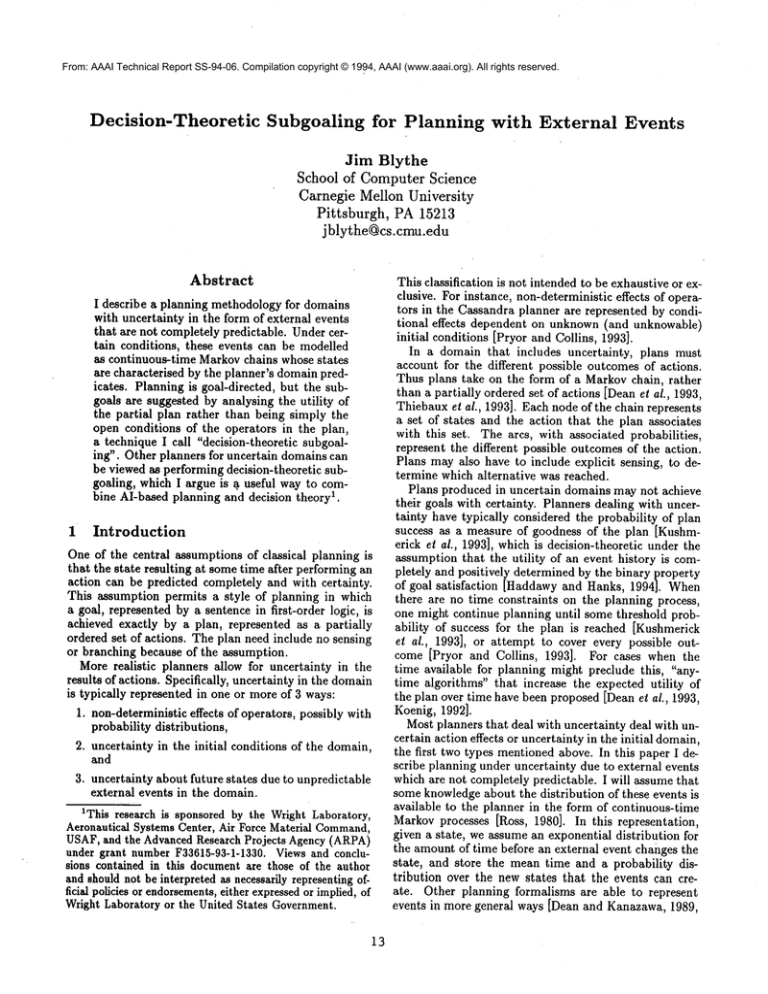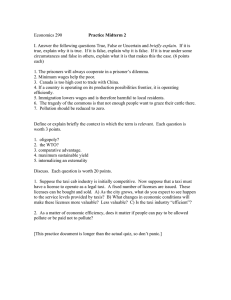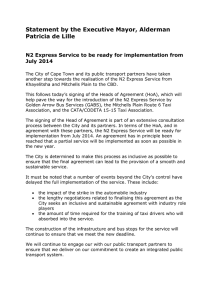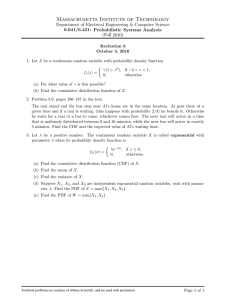
From: AAAI Technical Report SS-94-06. Compilation copyright © 1994, AAAI (www.aaai.org). All rights reserved.
Decision-Theoretic
Subgoaling
for Planning
with External
Events
Jim Blythe
School of Computer Science
Carnegie Mellon University
Pittsburgh,
PA 15213
jblythe~cs.cmu.edu
Abstract
This classification is not intended to be exhaustive or exclusive. For instance, non-deterministic effects of operaI describe a planning methodology for domains
tors in the Cassandra planner are represented by condiwith uncertainty in the form of external events
tional effects dependent on unknown(and unknowable)
that are not completely predictable. Under cerinitial conditions [Pryor and Collins, 1993].
tain conditions, these events can be modelled
In a domain that includes uncertainty, plans must
as continuous-time Markov chains whose states
account for the different possible outcomes of actions.
are characterised by the planner’s domainpredThus plans take on the form of a Markov chain, rather
icates. Planning is goal-directed, but the subthan a partially ordered set of actions [Dean et al., 1993,
goals are suggested by analysing the utility of
Thiebauxel ai., 1993]. Each node of the chain represents
the partial plan rather than being simply the
a set of states and the action that the plan associates
open conditions of the operators in the plan,
with this set. The arcs, with associated probabilities,
a technique I call "decision-theoretic subgoalrepresent the different possible outcomes of the action.
ing’. Other planners for uncertain domains can
Plans may also have to include explicit sensing, to debe viewed as performing decision-theoretic subtermine which alternative was reached.
goaling, which I argue is a useful way to comPlans produced in uncertain domains may not achieve
1.
bine AI-based planning and decision theory
their goals with certainty. Planners dealing with uncertainty have typically considered the probability of plan
success as a measure of goodness of the plan [Kushm1 Introduction
erick et al., 1993], which is decision-theoretic under the
Oneof the central assumptions of classical planning is
assumption that the utility of an event history is comthat the state resulting at sometime after performing an
pletely and positively determined by the binary property
action can be predicted completely and with certainty.
of goal satisfaction
[Haddawy and Hanks, 1994]. When
This assumption permits a style of planning in which
there are no time constraints on the planning process,
a goal, represented by a sentence in first-order logic, is
one might continue planning until some threshold probachieved exactly by a plan, represented as a partially
ability of success for the plan is reached [Kushmerick
ordered set of actions. The plan need include no sensing
et al., 1993], or attempt to cover every possible outor branching because of the assumption.
come [Pryor and Collins, 1993]. For cases when the
More realistic planners allow for uncertainty in the
time available for planning might preclude this, "anyresults of actions. Specifically, uncertainty in the domain time algorithms" that increase the expected utility of
is typically represented in one or more of 3 ways:
the plan over time have been proposed [Dean et al., 1993,
Koenig, 1992].
1. non-deterministic effects of operators, possibly with
Most planners that deal with uncertainty deal with unprobability distributions,
certain action effects or uncertainty in the initial domain,
2. uncertainty in the initial conditions of the domain,
the first two types mentioned above. In this paper I deand
scribe planning under uncertainty due to external events
which are not completely predictable. I will assume that
3. uncertainty about future states due to unpredictable
external events in the domain.
some knowledgeabout the distribution of these events is
available to the planner in the form of continuous-time
1This research is sponsoredby the Wright Laboratory,
Aeronautical Systems Center, Air Force Material Command, Markovprocesses [Ross, 1980]. In this representation,
USAF,and the AdvancedResearch Projects Agency(ARPA) given a state, we assume an exponential distribution for
the amount of time before an external event changes the
under grant numberF33615-93-1-1330. Views and conclustate, and store the mean time and a probability dissions contained in this documentare those of the author
andshouldnot be interpretedas necessarily representingoftribution over the new states that the events can creficial policies or endorsements,
either expressedor implied, of
ate. Other planning formalisms are able to represent
WrightLaboratoryor the United States Government.
events in more general ways [Dean and Kanazawa, 1989,
13
Haddawy,1991], but they do not specify planning mechanisms that make use of the information directly.
I describe a method of plan repMr for dealing with
this type of uncertainty that uses goal-directed search,
where the goals are suggested by decision-theoretic criteria. I argue in section 4 that this is a promising way
to combine the approaches of decision theory and AIbased plan synthesis. In the next section I describe the
representation for external events in more detail, and in
section 3 I illustrate the plan repair technique, which
is implemented on top of Prodigy 4.0 [Carbonell et aL,
1992], with a worked example.
Event:
Preconditions:
Deletes:
Adds:
Expected time:
lose-package-from-airport
(at ?package?airport)
((at ?package?airport))
((lost?package))
I/a
Figure 1: The event schema "lose-package-from-airport"
Figure 2: Markov model for taxis
2
Domain model
In order to simplify the description, I choose a domain
whose only source of uncertainty is external events. All
the operators are deterministic and the initial state is
knownwith certainty. In addition I ignore the cost of
obtaining information: the state is always known with
certainty during plan execution.
Consider the following simple transportation problem.
A number of packages are to be moved between locations, using combinations of taxis and airplanes. The
taxis are used to moveobjects around within a city, and
airplanes to moveobjects between airports of different
cities. The predicates of the domain, with the types
they expect, are "in(package, vehicle)", "at(object,
cation)", "lost(package)" and "have-key(locker)".
ject" is a super-type of "package", "vehicle".
There are seven operators, which have zero duration
unless stated:
load takes a vehicle and an object as parameters. The
precondition is that the two have the same location
andthe effect is that the packageis in the vehicle.
unload takes a vehicle and an object. The precondition
is that the object is in the vehicle and the effect is
that the object’s new location is the same as that
of the vehicle.
drive takes a taxi and a destination. The precondition
is that the destination be in the samecity as the taxi
and the effect is to makethe destination the location
of the taxi. This action has duration 1 hour, unless
the destination is the same as the taxi’s location in
which case it has no duration.
fly takes an airplane and a destination. This is like
"drive", except the locations must both be airports.
The duration is 5 hours if the destination is not the
current location.
open-locker takes a locker. It provides the key to the
locker so it can be used. This operator consumes$1
in resources.
store takes a package and a locker. The package must
be in the same airport as the locker and the planner
must be in possession of the key. The effect is to
put the package in the locker (a kind of location).
unstore takes a package and a locker. The package
must be in the locker, and the planner must have
the key. The effect is to remove the package from
14
the locker, placing it at the airport, and swallowing
the key.
In addition to the operators, we provide resource function Ur(h) that maps an event history to a measure of
the resources consumed. While only the "open-locker"
operator has an explicit cost attached, there is a charge
per hour per package for the use of a taxi or an aircraft.
The charge is $1 per hour for a taxi and $10 per hour
for an airplane, the cost being accrued from the time the
package is loaded to the time it is unloaded.
Lastly we provide an explicit model for the probability distributions of external effects. Manyresearchers
have investigated explicit modelsof external events, e.~:
[McDermott, 1982, Haddawy, 1991, Kanazawa, 1992J.
Here I take a very simplistic view and model external
events in a similar way to operators, with preconditions,
add and delete lists, and with an expected time to occur. The intended meaning is that if the preconditions
are satisfied, the operator may occur, and we model the
probability of its occurrence as exponentially distributed
with the given expected time, as long as the preconditions remain satisfied. For example, the event schema
lose-package-from-airport
is shown in figure 1. It
can be interpreted as meaningthat if a package is left at
an airport at time to, and no other events occur, then the
probability the packageis lost at time to + t is 1 - -at.
e
In what follows, I will sometimesrefer to the inverse of
the expected time of an event as its volatility.
In general, reasoning about the outcomes of plans in
the presence of external events is very difficult. In this
domain, however, the events act on disjoint parts of the
representation and hence the projection problem can be
decomposed, much as the planning problem can be decomposed for serializable subgoals [Korf, 1987]. Thus
the state description can be factored into independent
parts, each of which can be modelled by a continuoustime stationary Markovchain.
First we model the uncertainty of the location of a
taxi. A taxi can move from one location in its city to
any other with equal probability, and the expected time
for it to remainin its current location is 1/7 for each location. This is modelled by the event taxi-moves, which
in turn induces the Markovchain on taxi locations shown
in figure 2, because each taxi’s location is independent
of the other taxis and the other events of the domain,
and because there are only two valid locations for each
load Pittsburgh taxi
drive Pittsburgh taxi
Figure 3: Markovmodel for packages
unloadPittsburgh taxi
(airport
load plane
fly plane
Pittsburgh
Seattle
unload plane
Figure 4: Initial state for the exampleproblem
,L
load Seattle taxi
taxi.
Since there are only two valid locations for eachtaxi we
can easily calculate the probability distribution for the
location of a taxi at somefuture point, given its current
location, using the formulae:Psame(t)=~(11..~
e-27t),
-~Tt) [Ross, 1980], wherePsame(t)
and
Pdiff(t)
=
1(1e
¯
o
is the probability
that the taxi is in the samestate at
time to + t as at time to, and Pdiff(t) is the probability
that it is in a differentstate¯
Secondwemodel the probability of a package becoming "lost" from certain locations. Whena package is
lost it cannot be loaded by any vehicle. This is modelled
by the two event schemas lose-package-from-airport
and lose-package-from-post-office.
These are similar event schemas,but they have different volatilities.
Since no other events affect the locations of packages,
they induce the simple Markovchain shownin figure 3
and this in turn allows the location of a packageto be
modelledwith two exponential distributions, with an expected time for the packageto be lost from an airport
(l/a) anda post office (1/fl).
Again, it is simple to calculate the probability that a
packagewill be in a location at somefuture time to + t,
-~t
given that it is there at the current time to. This is e
for an airport.
3
Planning
with
external
events
Weare nowready to consider a simple planning problem,
whichis illustrated in figure 4. Wehavea packageat the
post office in Pittsburgh,to be deliveredto the post office
in Seattle. For this exampleI will modelthe utility of
an event history, h, as
U(h) = Vg(h) - V~(h)
whereUg(h) is $200if the event history h achieves the
given goal, and Ur(h) is the resource function, as described in the domainmodel. This is consistent with a
goal-directed agent as defined in [Haddawyand Hanks,
1994].Initially there is a taxi at the Pittsburgh post ofrice, an airplane at the Pittsburgh airport ready to whisk
15
drive Seattle taxi
unloadSeattle taxi
Figure 5: Initial plan (durations noted under operators)
the packageto Seattle, and a taxi waitingat Seattle airport.
The planner, as currently implemented,operates in a
loop as follows:
1. Generatean initial plan P, to achieve a state satisfying the goal description.
2. If P satisfies the terminationcriterion, basedon expected utility and/or planning resources, return P.
Otherwise
(a) Find a set of potential failures F. Each"failure" Consists of a step in the plan, a precondition of that step that maynot be satisfied, and
a sequence of events which would lead to the
precondition not being satisfied. Eachevent in
the sequenceis related to a set of steps in the
plan during whichit maytake place.
(b) Choosea failure to workon.
(c) Chooseone of the followingrepairs:
¯ Create a plan to achieve a goal state from
the state produced by the sequence of actions, and add this to P as a conditional
branch, should the event sequence take
place.
¯ Pick an event in the chain of events, and
attempt to protect P by adding steps to
negate the preconditionsof the event at the
time it can be applied
¯ Reduce the probability of the chain of
events by movingthe steps of the plan along
a time line in order to reduce the time over
fly
which the events can occur.
(d) Goto step
ad plane
In order to find the best plan, the planner must backtaxi present
track over all possible ways to fix a failure.
Since there is no uncertainty in the initial state or in
the effects of the operators, a classical planner could be
open locker
used to obtain the initial plan shownin figure 5. Next we
calculate the expected utility of the plan. This is complicated in general [Kushmericket al., 1993], but the task is
store package
muchsimplified in this case because of the restrictions on
the events discussed in the previous section. Weuse an
execution model under which execution ceases as soon as
drive Seattle taxi
a step of the plan is attempted that cannot be applied,
regardless of whether a subset of the plan could still be
executed to achieve some benefit. Any conditional exeunstore package
cution must be explicitly represented as branching in the
plan. Thus we can compute the expected utility by con.
sidering the probability that each action’s preconditions
are satisfied at the time the action is to be applied, and
the expected benefit of the state that results from the
1o~Seattle taxi
plan. In general, this is a lower bound on the probability
drivI1Seattle taxi
of success because we have not taken into account external events that might produce some utility irrespective
of steps in the plan being applied. In this case, however,
unloadSeattle taxi
our model does not contain any such events.
The planner derives the set of possible plan failures,
Figure 6: Final portion of the final plan
F, as a precursor to calculating the expected utility of
the plan. For the initial plan there is only one element
in F, which says that the step to load the taxi in Seattle
of the outcome if the event takes place, since no opmayfail, because the taxi has movedto the post office,
erators are then applicable, so instead the system tries
either while the taxi in Pittsburgh was moving or while
to decrease its probability. This can either be done by
the plane was in flight. The probability of this event
shortening the time that the system is in the state from
occurring over this time frame is Pdiff(6) ½(1 -e-!~7),
which the package can be lost, or by negating the prewhere7 is our measureof the volatility of taxis in Seattle.
conditions of the event lose-package-from-airport.
Taxis being what they are, we can assume 7 > 2, so
One option for the planner is to shorten the time in
this probability is just slightly less than ½. The utility
the state during which the event is applicable by entering
of the first part of the plan, delivering the package to
the state later or leaving it earlier. One wayto enter the
Seattle airport, is -$51 ($50 for the airplane and $1 for
state later is to delay unloading the package from the
the taxi). The utility of the second part is $199 if the
airplane until after the taxi has driven to Seattle airport.
taxi is present, and is 0 otherwise, giving an estimate for
The packageis, after all, safe in the airplane. This repair
the expected utility of -51 + ½(199) =$48.50.
to the plan can be found by posting constraints on the
Only one of the three techniques available to fix the
time intervals over which the steps are applied. This is
problem in the initial plan will work: re-planning from
an attractive repair technique, because no extra steps
the outcome when the event takes place. So the planhave to be added.
ner adds a conditional branch to call the taxi in the
Since this approach increases the cost of the plan,
outcome where it is not waiting at the airport. Weasthe
planner also tries to negate the preconditions of the
sume that the taxi will take 1 hour to arrive 2 and go
event. To do this, it subgoals on the goal of movingthe
to step 2, calculating the expected utility of the new
package from the airport as early as possible once it is
plan. While the Seattle taxi is arriving, the package
unloaded from the plane. The two-step plan to open a
can be lost with probability
1- e -a, in which case
locker and store the package there is found, with much
no action can be made to rescue the plan. Taking
lower cost than delaying the plane. The cheap extra step
a = 1, we estimate the expected utility of this plan to be
of removing the package again once the taxi has arrived
-51 + ½(199) +~e(198) ~ $85. Note that this estimate
is added to keep the plan consistent. The tail end of the
can be calculated incrementally as the plan evolves.
final plan is shownin figure 6. Its estimated expected
Again there is only one failure predicted for the plan,
utility is $147.
that of the package being lost, so the planner picks a
methodto fix it. It is not possible to increase the utility
4 Discussion and related work
I7
J
1
2The Markovrepresentation is an approximation that ignores the probability that the taxi is in transit.
In the last two sections I described a representation for
knowledgeabout the distribution of external events that
16
can affect a plan, and a planning method that makes
with a simple planning problem involving external events
use of this knowledge by subgoaling to improve the exwith known probability
distributions.
The explicit
pected utility of the plan. The plan with the highest
knowledge of both the causes and probabilities of the
expected utility was found by reasoning explicitly about
events allow the system to formulate subgoals that will
the causes of external events, and subgoaling in order to
improve the utility of the current plan.
increase the expected utility of the plan. The planner
The assumption that the events interact in such a way
essentially finds a point in the plan such that most event
as to allow the domain to be modelled as a group of
histories emanating from the point have relatively high
small, independent Markovchains is crucial in this paprobabilities and relatively low utilities. The different
per to allow the expected utility of a plan to be calcutechniques used for plan repair either try to increase the
lated quickly. Howeverit is a very restrictive assumption
utility of event histories from this point, or decrease the
in general, and one that I want to relax. I have impleprobability of reaching the point.
mented a Monte Carlo simulation technique that works
The use of decision theory to suggest goals to work
for a muchwider class ofl~roblems, and converges on the
on allows the planner to cope with more richly speccorrect value for the expected utility. I will begin a series
ified problems than an AI-based planner can typically
of experiments to investigate the tradeoffs between the
deal with, including different degrees of plan satisfaction
Monte Carlo simulation and the use of Markov models as
and operator costs. The use of goal-directed search to
an approximation to the domain. Since convergence of
achieve these subgoals brings with it a focus of attenthe simulation can be slow, however, I am also interested
tion that allows the planner to cope with problems with
in techniques which exploit knowledge of independence
higher branching factor than otherwise would be possiin the form of influence diagrams [Pearl, 1988], and more
ble. I refer to this combination as "decision-theoretic
systematic modelling techniques.
subgoaling". Planners for dealing with uncertainty in
Finally, this paper ignored the effect of the time taken
the state and in the effects of operators, such as BURIDAN to plan on the utility of the resulting plan, concentrating
[Kushmerick et al., 1993], Cassandra [Pryor and Collins,
on off-line planning. However, the analysis of dynamic
1993] also make use of decision-theoretic subgoaling to
planning domains and the increased planning complexity
an extent, although they do not have an explicit utility
both point to a need to take this into account. The
function. By planning for contingencies, and adding exuse of MonteCarlo simulation also lends itself well to
tra links to achieve preconditions, they are subgoaling to
techniques such as anytime planning [Dean and Boddy,
increase the probability of success of the plan.
1988]. I intend to relate the work described here with
I believe that the use of goal-directed search will be
previous work in that area [Blythe and Reilly, 1993].
necessary for any planner that deals with uncertainty in
Acknowledgements
a reasonably complex domain. To illustrate this point,
consider howa planner based on policy iteration, such as
Jaime Carbonell provided many useful suggestions for
used in [Dean et al., 1993]3, would approach this probthis work, and discussions with the Prodigy group were
lem. Policy iteration [Howard, 1960] computes the optivery helpful. The paper was improved by comments on
mal action for each state, given the set of all states and
earlier drafts from Rujith De Silva, Rich Goodwin,Scott
a mapping from an action and a state to a probability
Reilly and Bryan Loyall.
distribution of successor states. In order to make policy iteration tractable, Deanet al. restrict attention to
References
an envelope of the states contained in plans generated
[Blytheand Reilly, 1993] Jim Blythe and W. Scott
by an initial planner. Various schemes for incremenReilly. Integrating reactive and deliberative plantally increasing the envelope are considered, all based
ning for agents. Technical Report CMU-CS-93-135,
on adding a subset of the fringe, or the set of states
Carnegie Mellon University, May1993.
that can be reached with some probability by executing
[Carbonell
et al., 1992] Jaime G. Carbonell, and the
the current plan. None of these schemes would be able to
Prodigy Research Group. PRODIGY4.0: The mansolve the workedexampleof this paper, since states with
ual and tutorial.
Technical Report CMU-CS-92-150,
open lockers never appear on the fringe. In addition this
School of Computer Science, Carnegie Mellon Univerpath only shows greater utility when the two-step plan
sity, June 1992.
of opening the locker and storing the package is considered. The search space for considering all n-step plans
[Dean and Boddy, 1988] Thomas
from some envelope would quickly become prohibitive,
Dean and Mark Boddy. An analysis of time depenmaking goal-directed reasoning in some form necessary
dent planning. In Proceedings AAAI-88, pages 49-54.
to generate envelopes for policy iteration in a moderately
AAAI, 1988.
complex domain.
[Dean and Kanazawa, 1989] Thomas Dean and Keiji
Kanazawa. A model for reasoning about persistence
5 Conclusion and future work
and causation. Computational Intelligence, 5(3):142150, 1989.
Decision-theoretic
subgoaling combines goal-directed
search with a richer representation for plan utility. In
[Dean et al., 1993] Thomas Dean, Leslie Pack Kaelthis paper, I illustrated
and motivated the technique
bling, Jak Kirman, and Ann Nicholson. Planning with
deadlines in stochastic domains. In National ConferZsuitably generalised to reason about external events
ence on Artificial Intelligence, Washington, DC, 1993.
17
[Haddawy and Hanks, 1994] Peter Haddawy and Steve
Hanks. Utility models for goal-directed decisiontheoretic planners. Artificial Intelligence, to appear,
1994.
[Haddawy, 1991] Peter Haddawy. Representing Plans
Under Uncertainty: a Logic of Time, Chance and Action. PhD thesis, University of Illinois at UrbanaChampaign, December 1991.
[Howard, 1960] Ronald A. Howard. Dynamic Programming and Markov Processes. MIT Press, 1960.
[Kanazawa, 1992] Keiji Kanazawa. Reasoning About
Time and Probability. PhDthesis, BrownUniversity,
May 1992.
[Koenig, 1992] Sven Koenig. Optimal planning using
markovian decision theory. Technical report, UCB,
1992.
[Korf, 1987] Richard E. Korf. Planning as search: A
quantitative approach. Artificial Intelligence, 33:6588, 1987.
[Kushmerick et al., 1993] Nicholas Kushmerick, Steve
Hanks, and Daniel Weld. An algorithm for probabilistic planning. Technical Report 93-06-03, Department
of Computer Science and Engineering, University of
Washington, June 1993.
[McDermott, 1982] Drew V McDermott. A temporal
logic for reasoning about processes. Cognitive Science,
6:101-155, 1982.
[Pearl, 1988] Judea Pearl. Probabilistic Reasoning in Intelligent Systems. Morgan Kaufmann, 1988.
[Pryor and Collins, 1993] Louise
Pryor and Gregg Collins. Cassandra: Planning for
contingencies. Technical Report 41, The Institute for
the Learning Sciences, June 1993.
[Ross, 1980] Sheldon Ross. Introduction to Probability
Theory. Academic Press, 1980.
[Thiebaux et al., 1993]
Sylvie Thiebaux, Joachim Hertzberg, William Shoaff,
and Moti Schneider. A stochastic model of actions and
plans for anytime planning under uncertainty. Technical Report TR-93-027, The International Computer
Science Institute, May1993.
18





